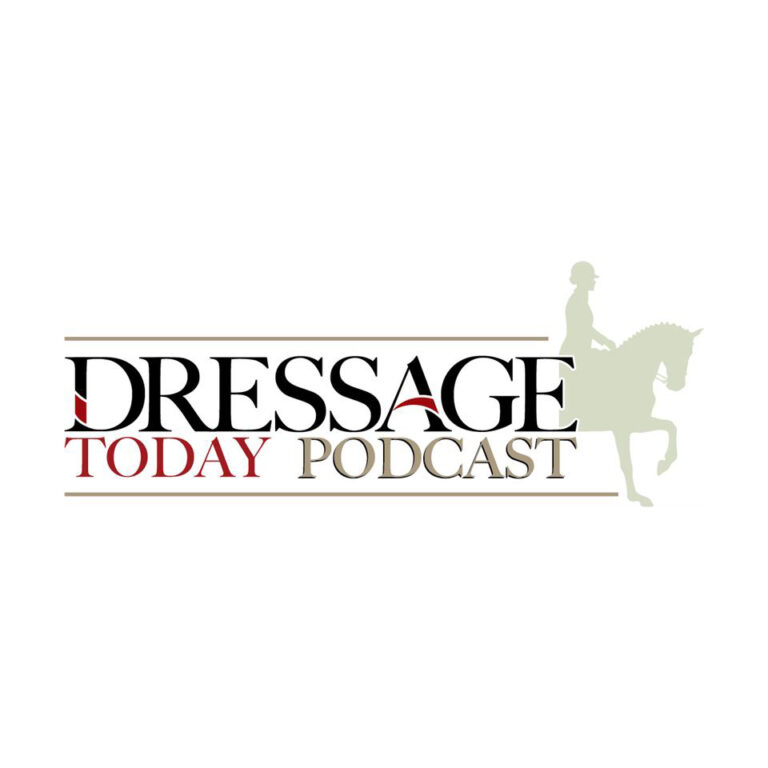As riders progress through the levels, they become increasingly aware of the importance of “the connection”—that physical link between horse and rider. The connection is made of energy that is shared, directed and recycled in a way that balances the horse in a shape that’s suitable for the work he is doing. For my horse Verdades (Diddy), working at the Grand Prix, I think of his shape as a box, but at Training and First Level, we might think of the ideal shape as an oval. Then at Third and Fourth Levels, the shape becomes a circle; and as you begin the FEI levels, there are times when you have a circle and times when your horse’s motion is crisp, clean and box-like because of the greater articulation of his knees and hocks.
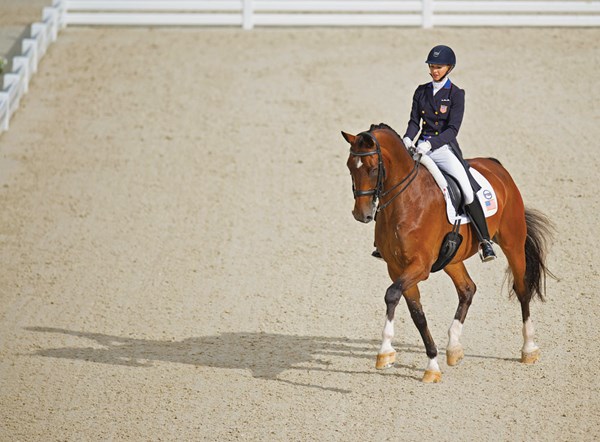
At Training and First Levels, the rider can get by with an unsteady connection, but by Second and Third Level, it becomes obvious when that link is missing. Fourth Level marks a clear point at which the horse is either ready for the international levels or he is not. To move on, a correct connection needs to be there.
Horses who work properly through their bodies in the connection make transitions easily. They stay sounder longer because they move with fluidity. The ideal connection allows maneuverability and a refinement of communication that make difficult movements happen with ease. When I train with Olympian Debbie McDonald, we primarily work on refining that connection. We don’t practice the “tricks” every day because they are easy when the connection is right. Mistakes in movements occur when the connection is lost.
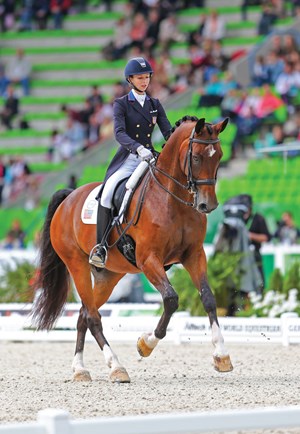
Two Tools for Connection Success
You need to bring the following tools to the game in order to have a proper connection:
• Educated aids—hands, seat and legs that are quiet and independent
• A horse that’s going forward and respects the rider’s aids
Let’s take a look at each tool:
Tool #1: Educated Aids
In order to achieve the ideal connection, the hands have to be completely independent. In addition, they need to:
• be supple so the horse wants to carry the bit rather than brace against it.
• be softly closed but ready to give, either forward or downward.
• be well trained, knowing when to release and when to hold the rein for an extra step.
The leg aid can be the most difficult of all to refine. The natural bounce of the horses’ gaits can make it difficult for many riders to achieve a quiet but functional leg. The refined leg has the ability to:
• …squeeze with the calf without touching the horse with a spur
• …deliberately use the spur when needed
• …control its positioning at all times
• …be completely neutral
• …apply an aid at different “volumes” and at different speeds.
• The left leg must be able to be separate from the right leg, and the use of the leg must not disrupt the seat.
The seat is the “command center,” which gives messages. The seat is between the horse’s energy-producing hind leg and the hand. It needs to have the ability to:
• …follow the motion of the horse’s back passively or
• …influence the way the horse’s energy reaches the hand. That is, it can hold the energy for a moment and create more suspension or it can allow the energy to reach and create bigger strides.
• The seat can move quickly or slowly to help the horse understand the rhythm and tempo the rider wants.
Tool #2: A Forward Horse Who Respects the Aids
Your horse is responsible for creating consistent energy, whether he’s walking, trotting, cantering, piaffing or doing an extended trot. This consistent energy shouldn’t be mistaken for “impulsion.” True impulsion requires a certain amount of strength that develops over time. The horse must simply, on his own, be self-motivated, creating steady, dependable forwardness so the same amount of energy gets to the bit every single stride. It’s the rider’s job to hold the horse accountable. Young horses might be timid or perhaps they pull (they are all different), but teaching them to create their own consistent energy and be sensitive to the aids will also teach them to accept the bit—as opposed to struggle against it.
When the horse doesn’t maintain a steady forward energy, he may momentarily go faster when the rider puts her legs on, but then slow down, requiring the rider to use the legs again. Some horses have the reverse tendency. They go faster and faster. Those horses need to respect the half halt. In any case, you don’t want to be using your aids to constantly regulate the horse’s speed. Horses that are consistent find their jobs more enjoyable. The ride is just nicer when the flow of energy stays the same. Then that energy can be recycled by half halts, making the work easier.
The Half-Halting Rein
When the horse’s energy flows consistently over the back and to the bit, the rider’s hand should not stop the energy. The hand is not like a cul-de-sac at the end of a road; the hand is like a roundabout. It has options regarding where it can send the energy. If the horse is in balanced motion on the short side of the arena, the hand can say, Maintain, maintain, maintain, sending energy back to the hind end so it can continue to reproduce that motion. Or the hand might say, I’m going to let your energy out so you can extend. The hand doesn’t even stop the horse’s energy in the Training Level halt on the centerline. The halt simply pauses the energy on the hind legs, and from that halt, the horse can go forward easily because the energy was never lost.
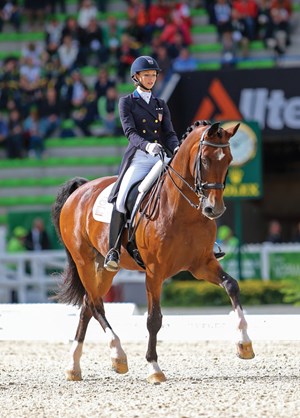
The half halt is ideally executed with one rein or the other because if you use both reins at the same time, it can cause a dead-end interruption that prevents the recycling of the horse’s energy. Riders tend to talk about the outside rein primarily because we spend so much time in an arena where there’s a clear inside and outside. Instead of the outside rein, I like to refer to the “half-halting rein,” which might be on the inside or the outside—whichever rein the horse feels heavy on. The half-halting rein controls the shoulders and creates straightness so the horse can transfer equal weight to each of the hind legs.
As we all know, the majority of the horse’s weight is, by nature, on his forehand. Half halts shift his weight off the front end to the hind end, making it easier to balance. Although it is physically harder for the horse to carry weight with the hind legs, as the hindquarters strengthen, the work is easier for the horse because he is balanced.
Half halts balance the green horse by slowing him down and allowing his strides to be smaller. The faster the horse goes, the harder it is to balance. When the rider teaches the young horse to go consistently forward, half halts slow him down, adding weight automatically to the hind legs. When half halts have successfully balanced my horse, I feel like he’s moving forward between my legs and my reins. I don’t feel him stronger on one rein or the other, and he’s not leaning on one leg or another. In that balance, I can do anything: I can halt, do an extension, half pass left or right.
The balance feels delicate—as if I could throw him off easily. If I hold the half-halting rein a split second too long, I interrupt the gait. But if I hold it for too short a time, I don’t make any change at all. In my lessons with Debbie, we spend a lot of time on this. Debbie might say, “That half halt was too strong,” or she might say, “No, you really need to bring him back more than that.” These half halts help determine his shape.
Adjustments Inside the Box
The shape of the horse also comes from the amount of energy he’s producing and the package that your legs, seat and reins create within which his energy recycles. The shape of my horse’s body is the box within which he is well-balanced.
Before the World Equestrian Games, I was working on the piaffe and passage box with Diddy. He’s very talented at these movements, but he is still green. In schooling, it helps me to work on the shape of his box—or the shape of his body. If he were to get behind the leg and I were to kick him, he would jump forward out of the box—which creates a major interruption in the rhythm and balance.
Likewise, if I bring him back for the piaffe and make the mistake of using too much hand, he might think to move backward or he might even walk. In that case, he falls out the back side of my box. Neither of those outcomes helps. I have to be able to adjust everything inside the box. Debbie always tells me, “Stay in the box.”
We’re also constantly working to keep Diddy straight, which makes him more upright and, for example, gives more height to his passage. In this case, I imagine a more vertical rectangle for a box. If I want to let him out a little, the top of my box comes down. Then if he gets too flat, I might put my leg on in a way that my box gets taller. I’m careful not to give him an aid that might make him jump out of my box. I need to be sensitive enough to be able to make the adjustments in a helpful way rather than make an overly ambitious correction that he perceives as a punishment and that might send him out of the box. A breath or an ounce of difference in my weight can create a perfect transition or a total disaster. Transitions are the best exercises to help you confirm the connection inside the box with your horse, but before you begin them, check the sidebar to see that you have the proper rein length.
Transition Exercises
Problems in transitions usually occur because the horse tries to get out of the box. He might go through the rider’s half halt and out the front of the box, or he might hesitate in his forward thinking and go out the back. Debbie would say, “Stay in the box!” Although the box should be supple, its shape shouldn’t change unless you decide to change it. Transitions all have to happen within the box that you give your horse whether you’re on a straight line, a bent line or in a movement such as shoulder-in.

Try the following exercises on a 20-meter circle. That’s where I spend most of my time—improving the quality of my connection with transitions. Ideally, you want to be sure your horse is in perfect balance two strides before you ask for the transition. Then, in the next stride, you want to tell your horse what to do.
Your goal in these exercises is to keep your horse in the box. No matter how cooperative your horse is, you’ll find that it’s not his natural inclination to stay in the box. You need to teach him that. Here’s how:
• When you decide to make a downward transition (for example, to walk from trot), you will probably feel your horse slide backward out of the box. This is a common problem because the horse is interested in stopping so he slips behind the leg.
• At that moment, change your mind. The second you feel your horse start to fall out of the box, go forward again to get him back inside the box.
• Next, play with your horse in a more detailed way. Instead of asking for walk, ask for “almost walk” until you feel him starting to slip out of the box again. Then push him forward again.
Eventually when you ask for walk, your horse will balance so that he thinks “almost walk” and stays in front of the leg in his downward transitions. In the upward transitions you want a prompt transition from an aid that doesn’t send him out of the box in front of you. If you know which aid is too much, and you know what’s not enough, you can find that place where you don’t need to make big adjustments. As your horse gets quicker off the leg in the upward transitions, the downward transitions will get easier. You’ll find that your horse will be constantly waiting for you to say something, and he’ll be reactive when you do. Apply these principles to three kinds of transitions:
Exercise 1—Transitions that Shift One Gear
These transitions are between two adjacent gaits: halt–walk–halt, walk–trot–walk and trot–canter–trot. Start on a 20-meter circle, and try your transitions at two different spots—perhaps each time you come to the centerline. If your horse isn’t in balance at the time when you want to do a transition, simply don’t do it, because he won’t be able to do it on the aids. Balance him in the box first.
Exercise 2—Transitions within One Gear
These transitions are within the gait itself. Try the simplest form of this transition, from the working walk to the free walk and back to the working walk. Next, from working trot or canter to lengthening and back to working, or from the collected paces to the medium and back to collected. In the upward transitions, your box will get longer as your horse’s frame and stride lengthen, and in your downward transitions, your box will get shorter and higher.
It will be immediately evident if your horse isn’t consistently forward. When a horse that is not maintaining his own energy tries to extend, there is no energy to collect in the corner and he has to create energy he never had for the extension. When your horse is consistently forward, your “almost transitions” in Exercise 1 will allow you to balance your horse back and put him in the right box to be successful in the movements.
Exercise 3—Transitions that Skip a Gear
These are transitions that skip a gait: Halt–trot–halt, walk–canter–walk. The previous exercises will prepare your horse by teaching him to engage, or carry weight, in each transition. Transitions that skip a gait directly develop collection because your horse needs to engage and carry in the downward transitions and he needs to lift his torso and thrust upward in the upward transitions.
These transition exercises will refine your connection to help your horse’s movement be more fluid and make his work easy.
Check for Proper Rein Length In Transitions
When the connection is correct, it shouldn’t be necessary to change your rein length when you go from gait to gait. When I’m teaching, I find that many riders unconsciously shorten their reins when going, for example, from walk to canter. If that’s necessary, it means the reins were too long in the first place. Riding with reins that are too long is a common habit and it causes a missing link in the connection. When the reins are too long, the parking brake is on, and the energy gets stuck in the rider’s lap.
Riding with reins that are too short is less common, but it usually happens out of desperation—either from trying to put the horse on the bit or sometimes from dealing with a tense horse. If the reins are too short because of a concern for safety, by all means keep them short. But the goal is to have the horse stretch his neck, and a longer rein often allows the horse’s energy to come through so he can then relax in his neck.
When it comes to determining rein length, it helps to have the eyes of a trainer, but if you can’t, keep the following in mind:
• Your hands should be in front of the withers but not touching them.
• They should always be low enough that you could scratch your horse’s withers with your pinky.
• Although the hands should be low, the rider shouldn’t push them down or let them hang down. Carry them and keep a supple elbow.
Once the rein length is established, you and the horse know how much energy you need to fill that rein length and make good transitions.
Beyond the Mouth
When riders think of “connection,” they often think about the mouth. But when a horse is fussy in the mouth, it’s rarely just a matter of changing the bit or the noseband. That said, you do need to be sure your horse’s tack is comfortable, and having the correct bit was an important piece of the puzzle for me. When Diddy was 10, he severely fractured his jaw while playing with his stall door. It had a section of top bars that were on hinges, and someone forgot to lock them in place. He was playfully swinging it when he got a wolf tooth caught as the bars slammed into place. He panicked until he was free, breaking his jaw in the process. Surgery repaired his jaw with screws, but for many months we weren’t sure he would ever wear a regular bridle with a bit. After I found a bit that was comfortable for him, our whole world changed for the better. If you have a special situation as I did, or if your horse needs to see a dentist, those issues need to be remedied before the connection can work correctly, regardless of how beautifully you ride. It was a big deal for us, but it’s not the piece of the puzzle that is the focus of this article. If your horse is fussy in the mouth and seems to be on your aids otherwise, changing the bit might help, but we usually look beyond the mouth to create the ideal connection.
At Home with Laura Graves: The Nonfiction Fairy Tale
From the time I started riding, I always wanted to ride for the U.S. Equestrian Team. I’m a competitive person by nature, but I didn’t excel in school, I don’t dance or sing and I’m not very athletic in other ways. I just wanted to ride. Years ago, I didn’t even have a real idea of what “the team” was, but I knew it was where the sport peaked. Who knew this would happen to me when I was so young and with a horse I have an incredible relationship with?
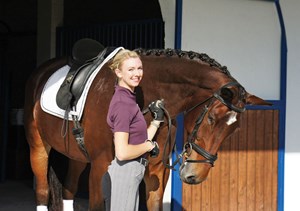
I grew up in Vermont with my parents until I was 19. My first dressage show was Lendon Gray’s Dressage4Kids in 1999. A few girls from our barn convinced me to go with my little Quarter Horse named Sunny. That was it for me; I loved it. Ever since then I have only shown dressage. At Lendon’s show, we had to prove our knowledge on the written test and prove our riding skills in the equitation part. If you had an average horse and didn’t win your dressage test, you could still do very well. I continued riding at Dressage4Kids until Sunny retired.
When I was 19, I moved to Florida and worked with Anne Gribbons for three years as a working student. I brought Verdades (Diddy), the horse that my mother had purchased as a foal in 2002. During that time Diddy and I did the small tour, but no one knew who I was even though we had some fairly strong finishes in Wellington.
During 2013 I was on my own, and it was a real struggle to find help. I had met Debbie McDonald in 2010 at a dressage-star search at Gladstone. Diddy and I were one of two pairs selected to participate in her clinic for elite riders, and she really helped me. In 2013, I drove nine hours from the Orlando area to Georgia for a lesson with her. She told me she would be spending the winter season in Florida, so I emailed, texted and begged for her time. Wherever she was, I showed up—at whatever time in whatever place she wanted. It was just what I needed.
I hope my experience will open people’s eyes. It feels like the riders at the top stay at the top. But there are great horses and riders out there who, if they had the best coaching, could succeed. At the same time, the powers that be are not going to come find you in East Podunk, USA. They’re genuinely busy.
Now, it feels good to be home. I’ve learned that the way I spend my day is unusual because I still do a lot of the barn work. I’m a big part of my horses’ day, aside from the riding and training because I clean stalls and groom them. I just love them. I don’t love dressage and then love the horses. I love the horses first and dressage just happens to be a part of it. I’m so grateful to the people who have helped me. Sometimes I just send Debbie a random text message, “I’m so thankful for you.” I don’t think this could be much sweeter.
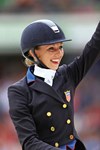
Laura Graves is a USDF gold medalist, 2014 reserve champion at the Festival of Champions, member of the United States Equestrian Team and currently ranked #21 in the FEI World standings. Growing up in Vermont, she always had a love for horses. In 2000, she turned that love into a sole focus on the sport of dressage where she excelled. In 2014, Graves and her top horse, Verdades, aka Diddy, were named to the U.S. dressage team for the World Equestrian Games. They finished fifth in the Grand Prix Kür and became the second-ever American pair to score over 80 percent in international competition. Graves has her own training and sales business located in central Florida. When not at the barn, she spends time with her family, including one of her strongest supporters, her boyfriend, Curt, and her four-legged canine supporter, Cami.



